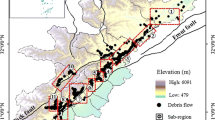Abstract
Critical rainfall assessment is a very important tool for hazard management of torrents and debris flows in mountainous areas. The Wenchuan Earthquake 2008 caused huge casualties and property damages in the earthquake-stricken area, which also generated large quantities of loose solid materials and increased occurrence probabilities of debris flows. There is an urgent need to quantify the critical rainfall distribution in the area so that better hazard management could be planned and if real time rainfall forecast is available, torrent and debris flow early-warning could be issued in advance. This study is based on 49-year observations (1954–2003) of up to 678 torrent and debris flow events. Detailed contour maps of 1 hour and 24 hour critical rainfalls have been generated (Due to the data limitation, there was insufficient 10 minute critical rainfall to make its contour map). Generally, the contour maps from 1 hour and 24 hours have similar patterns. Three zones with low, medium and high critical rainfalls have been identified. The characteristics of the critical rainfall zones are linked with the local vegetation cover and land forms. Further studies and observations are needed to validate the finding and improve the contour maps.
Similar content being viewed by others
References
Bianco, G and Franzi, L. 2003. Comparison of Debris-flow Events in three contiguous basins, triggered during the same Storm Event. Debris-flow Hazards Mitigation: Mechanics, Prediction, and Assessment, Proceedings 3rd International DFHM Conference, Davos, Switzerland, Rotterdam: Millpress. Pp. 943–954.
Caine, N. 1980. The Rainfall Intensity-duration Control of Shallow Landslides and Debris Flows. Geografiska Annaler 62:23–27.
Cannon, S.H. and Ellen, S.D. 1985. Rainfall Conditions for Abundant Debris Avalanches, San Francisco Bay region, California. California Geology 38(12): 267–272.
CHEN Bo, WEI Lunwu, WU Chun. 1989. Analysis on the Method of Pattern Recognition on the Development, Distribution and the Restrictive Elements of Debris Flows in Southwestern China. Bulletin of Soil and Water Conservation 9(2): 54–56.
CHEN Ningsheng, ZHANG Fei. 2006. Movement and Deposit Characteristics of Typical Catastrophic Debris Flows by Rainstorm in the Mountainous Area of Southwestern China in 2003. Geography Science 26(6): 1–8.
CHENG, J.D, Yeh, J.l, Deng, H. L. Wu and C.D. Hsei. 2003, Landslides and Debris Flows Induced by Typhoon Toraji, July 29–30, 2001 in Central Taiwan. Debris-flow Hazards Mitigation: Mechanics, Prediction, and Assessment, Proceedings 3rd International DFHM Conference, Davos, Switzerland, Rotterdam: Millpress. Pp. 919–930.
Dhital, M. R. 2003. Causes and Consequences of the 1993 Debris Flows and Landslides in the Kulekhani Watershed, Central Nepal. Debris-flow Hazards Mitigation: Mechanics, Prediction, and Assessment, Proceedings 3rd International DFHM Conference, Davos, Switzerland, Rotterdam: Millpress. Pp. 931–942.
Google map, 2009, http://ditu.google.com
Keefer, D.K., Wilson, R.C., Mark, R.K., Brabb, E.E, Brown, W.M, Ellen, S.D., Harp, E.L., Wieczorek, G.F, Alger, C.S. & Zatkin, R.S. 1987. Real-time Landslide Warning during Heavy Rainfall. Science 238(4829): 921–925.
Jomelli, V., Brunstein, D., Chochillon, C. Pech, P. 2003. Hillslope Debris-flow Frequency since the Beginning the 20th Century in the Massif des Ecrins (French Alps). Debris-flow Hazards Mitigation: Mechanics, Prediction, and Assessment, Proceedings 3rd International DFHM Conference, Davos, Switzerland, Rotterdam: Millpress.Pp.127–138.
Tan Wanpei. 1986. The Research on the Distribution Characteristics and Activity Rule. Journal of Railway Engineering Society 4:96–100.
TAN Wanpei, WANG Chenghua, YAO Lingkan. 1994. The Regional Forecast and Prediction in Landslide and Debris Flow. Pp. 114–115.
TAN Wanpei. 1992. Study on Regional Critical Rainfall Indices of Debris Flow in Sichuan Province. Journal of Catastrophology 7(2): 37–42.
Tao Jiayuan. 1995. The Distribution of Disastrous Debris Flow in China. Journal of Higher Correspondence Education (Natural Science) 4:6–7.
Wieczorek, G.F. 1987. Effect of Rainfall Intensity and Duration on Debris Flows in Central Santa Cruz Mountains, California. In J.E. Costa & G. F. Wieczorek (eds), Debris Flows/Avalanches: Process, Recognition, and Mitigation; Reno, Nevada, Geological Society of America, Reviews in Engineering Geology 7: 93–104.
WU Jishan, KANG Zhicheng, TIAN Lianquan, ZHANG Shucheng. 1990. The Observation and Research of Debris Flow in Jiangjia River. Beijing, Science Press Pp. 62–70.
Yu Shuhua, He Guangbi, Xu Huiming, Gao wenliang. 2005. A Precipitation Forecast Method and Rainfall Standard of Debris Flow and Landslips Happening. Journal of Mountain Science 23(2): 158–164.
Author information
Authors and Affiliations
Corresponding author
Additional information
An erratum to this article is available at http://dx.doi.org/10.1007/s11629-010-1001-y.
Rights and permissions
About this article
Cite this article
Chen, N., Yang, C., Zhou, W. et al. The critical rainfall characteristics for torrents and debris flows in the Wenchuan earthquake stricken area. J. Mt. Sci. 6, 362–372 (2009). https://doi.org/10.1007/s11629-009-1064-9
Received:
Accepted:
Published:
Issue Date:
DOI: https://doi.org/10.1007/s11629-009-1064-9




